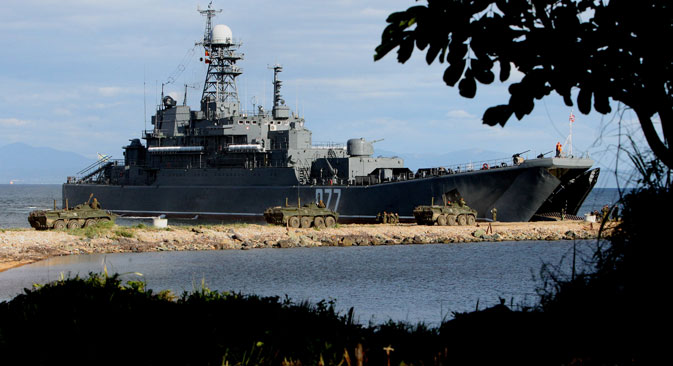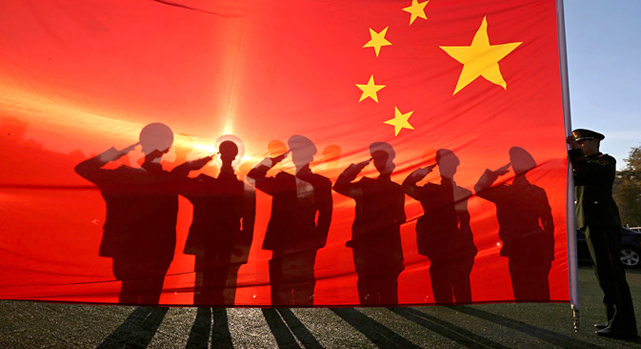Why Russia and China gatecrashed Club Med

The large Russian amphibious assault ship Peresvet during the loading of military equipment and personnel of the naval infantry brigade of the Pacific Fleet as part of a sudden check of the combat readiness of the troops of the Eastern Military District. Source: RIA Novosti
The Mediterranean Sea is no longer the exclusive preserve of European and American fleets. On May 11, two powerful eastern navies steamed into this strategic sea that connects Europe, Africa and the Middle East. For a 10-day period, nine ships from the Russian Navy and China’s People’s Liberation Army Navy (PLAN) conducted their first joint naval war games in European waters.
So what was the purpose of this gunboat diplomacy? Codenamed Joint Sea 2015, the naval exercise off NATO’s weak southern underbelly were a signal from Russia and China that if the West can meddle in Eastern Europe (against Russia) and the Asia-Pacific (against Chinese interests), then two can play the game. If the West targets them, then both countries will work with each other to protect their interests.
The two fleets brought along only a small contingent of fighting ships, but the firepower was still impressive. As well as submarines, guided missile corvettes, missile frigates and landing ships, there was the guided missile cruiser, Moskva, which was specifically designed to take out American aircraft carriers.
The Moskva’s unique battery of sixteen SS-N-12 Sandbox surface-to-surface missiles sited in two rows along either side of the bridge superstructure gives her formidable firepower and also makes this class easily recognizable.
China sent a pair of 4,000-ton Type 54A Jiangkai II frigates – the ‘Linyi (574)’ and the ‘Weifang (547)’ as well as a replenishment ship, the ‘Wei Shanhu,’ to the Mediterranean.
Russia: Not lonely any more
The exercise comes at a time when relations between Washington and Moscow have plummeted to post-Cold War lows amid the disagreements over Ukraine, Crimea and Syria.
At a time when the West has imposed sanctions against Russia, ratcheted up its covert and overt military activity in Ukraine, and boycotted the WW II victory celebrations in Moscow, the joint exercise with the world’s economic engine – and future superpower – certainly gives Russia some bragging rights.
It is also a way of showing to whomsoever it matters that even if the Russian military is a shadow of the mighty Soviet Union, it is still a potent force. In fact, the Mediterranean drill was the latest in a series of Russian land, sea and air military drills conducted throughout the world in recent months.
Joint exercises also give Russia the opportunity to show off its newest military gear. Sometimes it pays off in terms of sales. A few weeks after joint drills in 2005, China placed a large order for one of the participating warplanes, the Il-78 tanker.
What’s in it for China
The Mediterranean foray was the furthest the Chinese navy has travelled to take part in training. To the Chinese this must be especially sweet irony. A century ago, Chinese littoral waters were penetrated by a bunch of European navies, which were the battering rams that forced open the country to rapacious colonization and loot. China hasn’t forgotten that humiliation. Therefore, sailing Chinese warships in waters where Greek and Roman fleets once ruled the waves and which was until recently a virtual European lake, is party strongman Xi Jinping’s way of catering to Chinese nationalism.
To be sure, China’s geopolitical concerns are currently centered in the Asia-Pacific, where the US is entering into alliances with regional powers in a bid to surround China. But by sailing out into the Mediterranean, Beijing complicates matters for the American security establishment. The US will henceforth have to reckon with Chinese fleets challenging American dominance in the Pacific and elsewhere.
Significantly, China also breaks free of the Asian straitjacket and presents itself as a growing power with global reach. This lowers Washington’s prestige a few notches because now there’s another great power in the reckoning. Where earlier it had to deal just with Russia, now it has to factor in China too.
At the same time, China has a pressing need to get involved in the Middle East and North Africa, where it has legitimate commercial interests. The country’s growing economic role in the region and the importance of securing shipping lanes for its trade have given the Chinese a new focus.
Moscow Beijing tango
Russia and China have two of the world’s most powerful militaries, and their growing defense cooperation is watched with keen interest worldwide. However, most experts have gone ballistic over the Mediterranean foray despite that fact that both countries have conducted a major bilateral or multilateral joint exercise on an almost yearly basis.
According to Richard Weitz, director of the Centre for Political-Military Analysis at the Hudson Institute, the first of these exercises occurred from August 18-25, 2005. The Chinese and Russian militaries conducted a three-phased operation that began in Russia's far eastern city of Vladivostok and then moved to China’s Shandong Peninsula, where the participants conducted land and then amphibious maneuvers.
Whereas the PLA supplied most of the troops (8,000 versus 2,000), the Russians provided the most sophisticated equipment, such as Russian Tu-160 and Tu-95 strategic bombers, as well as some 140 warships. The maneuvers practiced included neutralizing anti-aircraft defenses, enforcing a maritime blockade, and conducting an amphibious assault and other joint naval operations. One Russian analyst described the exercise as rehearsing “a conventional all-out assault using the Russian and Chinese tactics developed in the 1970s and 1980s”.
“Not even during the 1950s – when China belonged to the Soviet bloc and had a formal mutual defense treaty with Moscow – did the two countries carry out such a large joint exercise,” writes Weitz.
So basically, the Mediterranean war games should be seen as part of a series of coordinated moves by the Russian and Chinese militaries to achieve synergies and combat familiarity.
No more fratricide
Many western experts dismiss Russian and Chinese cooperation as the “axis of convenience”. In their view, Moscow and Beijing are coming together because they have no friends. They believe, both countries lack common strategic goals and will therefore fall out with each other sometime in the future just as they did after bitter squabbling and fighting during the 1960s.
However, these experts couldn’t be more wrong. Back in the 1950s and 1960s, Moscow made serious diplomatic blunders by treating the Chinese communists as their subordinates. The closed-minded communist dictator Joseph Stalin and his successors assumed the Chinese communists would automatically toe the Russian line. The Chinese were in no mood to oblige and the communist bloc split was the result.
The split was totally ideological in nature and had no origins in geopolitics. This is something Russian and Chinese leaders understand very well and are therefore anxious not to let it happen again. At any rate, with communism lying in the dustbin – where it really belongs – Moscow and Beijing have nothing to worry on that account.
So those expecting a second fallout are going to be disappointed. They should worry about all that firepower in the Mediterranean.
The opinion of the writer may not necessarily reflect the position of RBTH or its staff.
All rights reserved by Rossiyskaya Gazeta.
Subscribe
to our newsletter!
Get the week's best stories straight to your inbox

